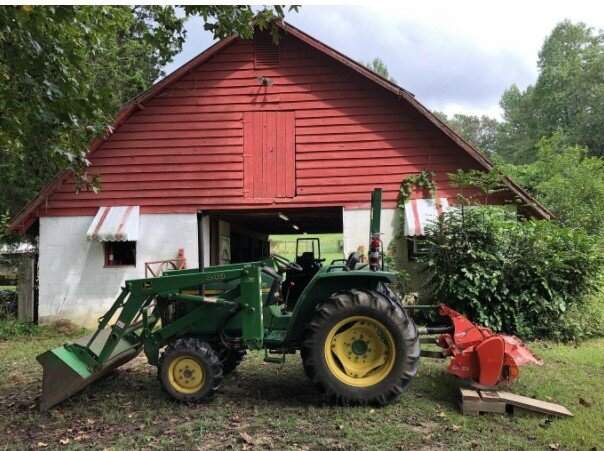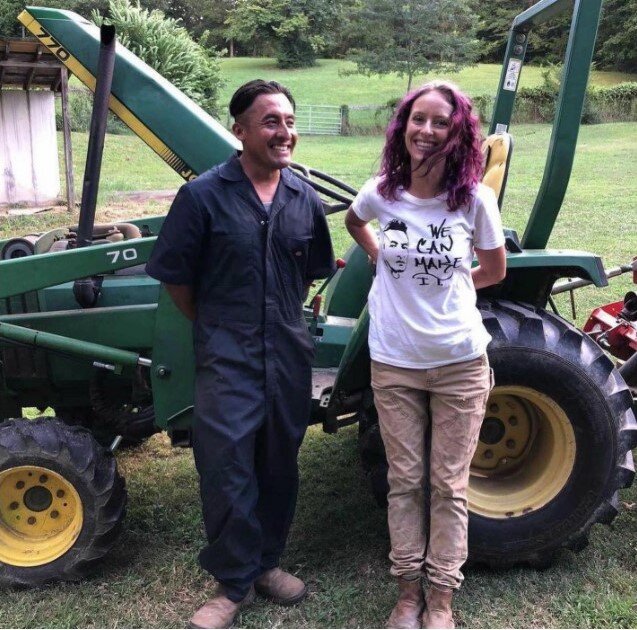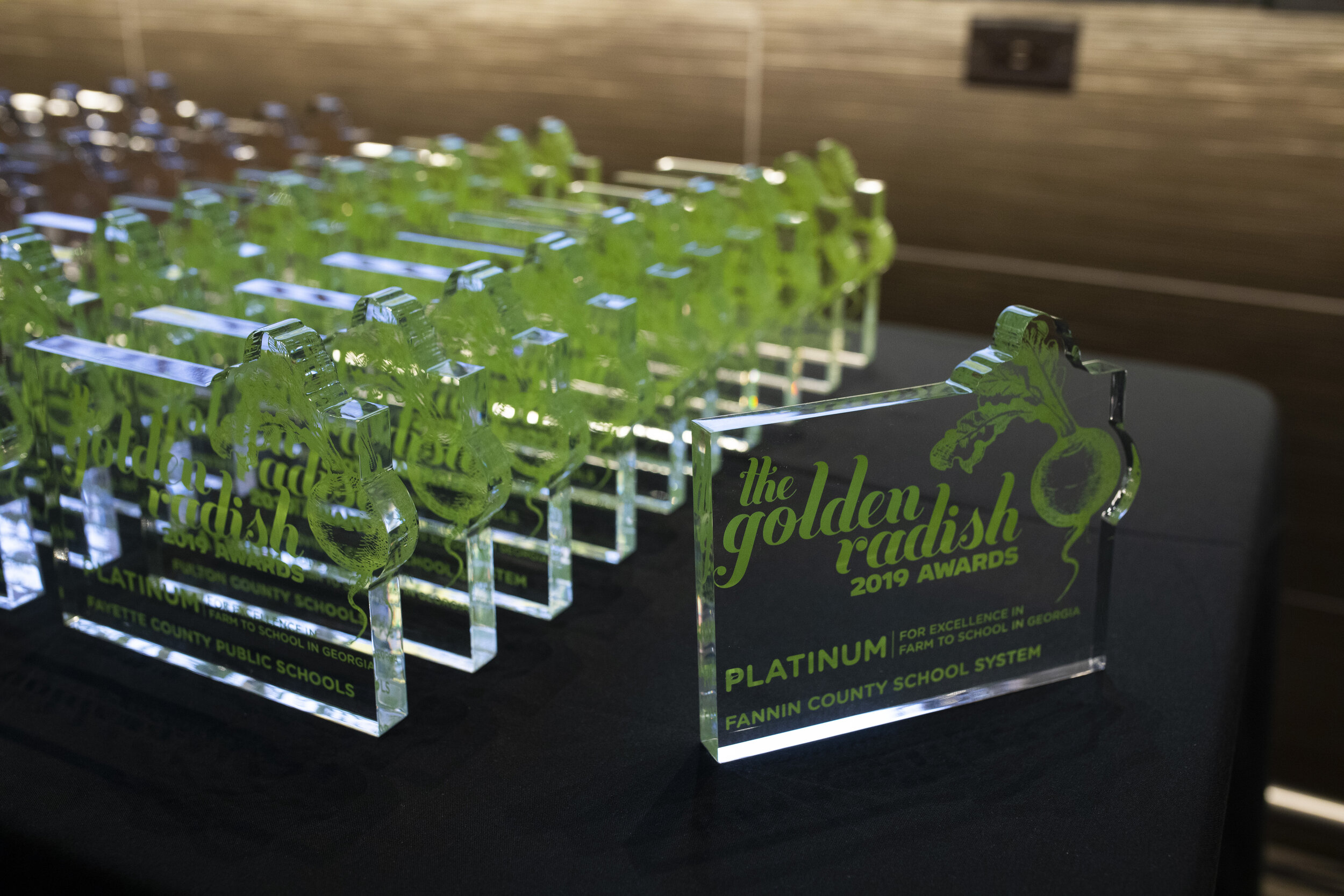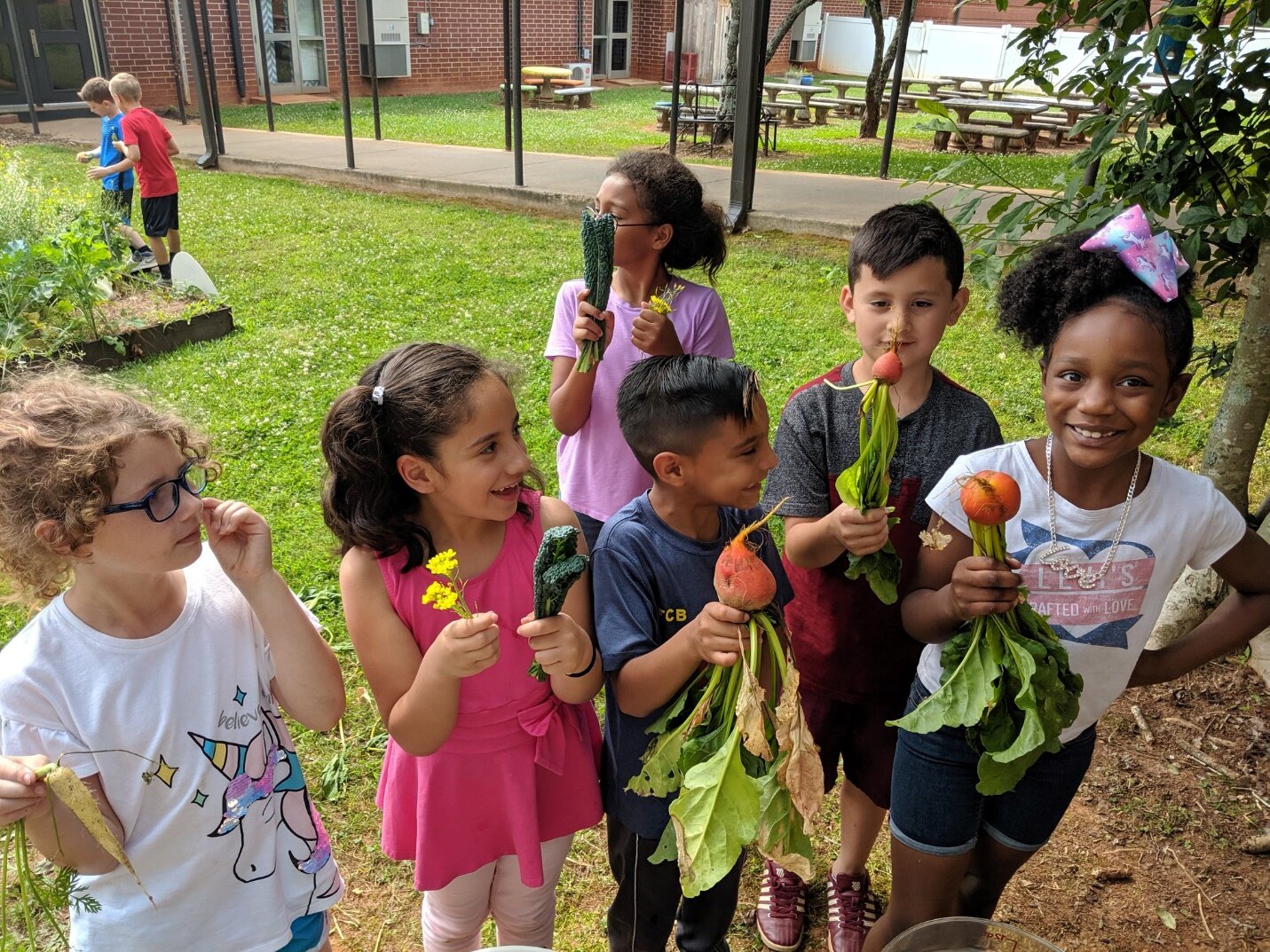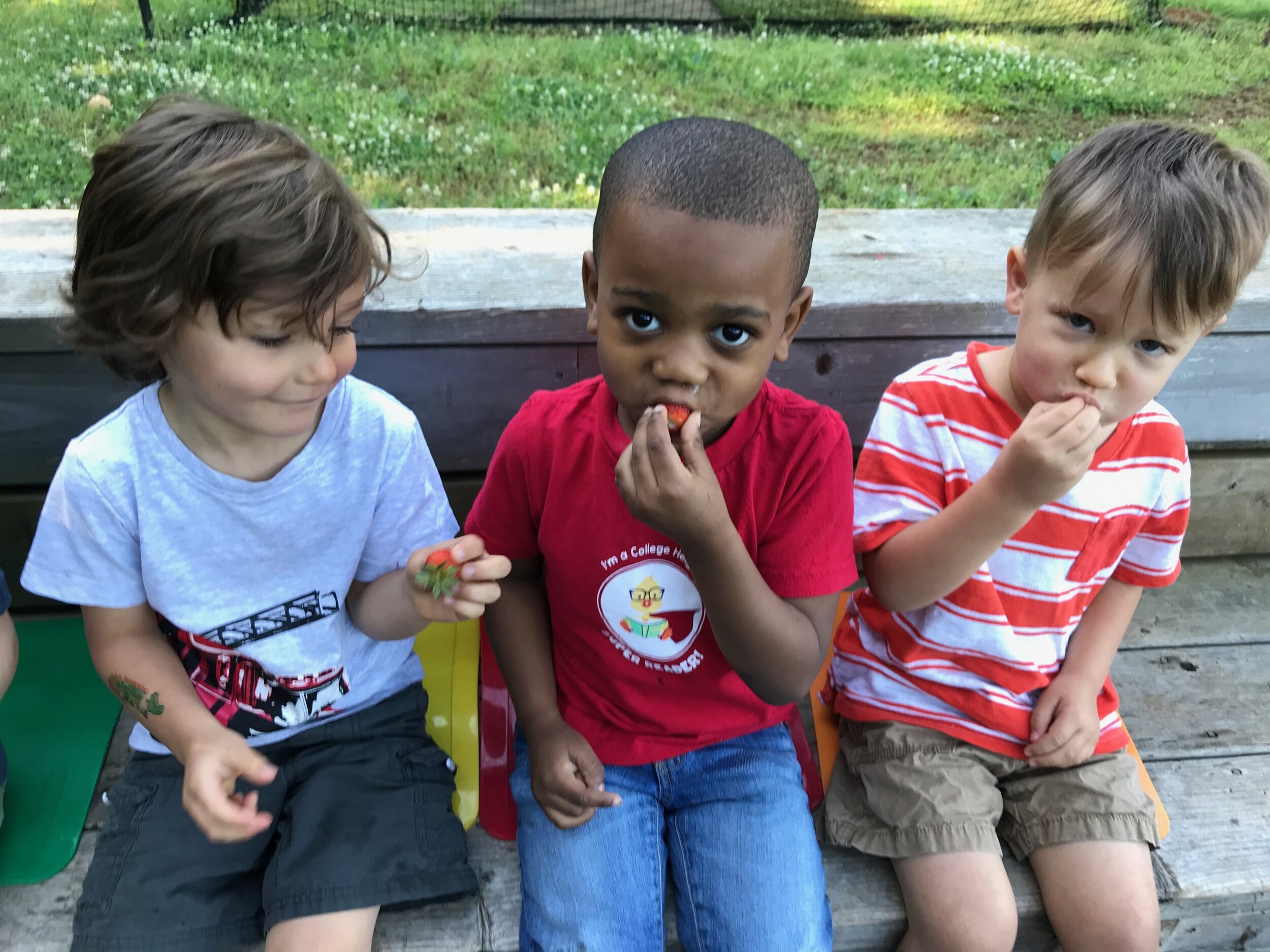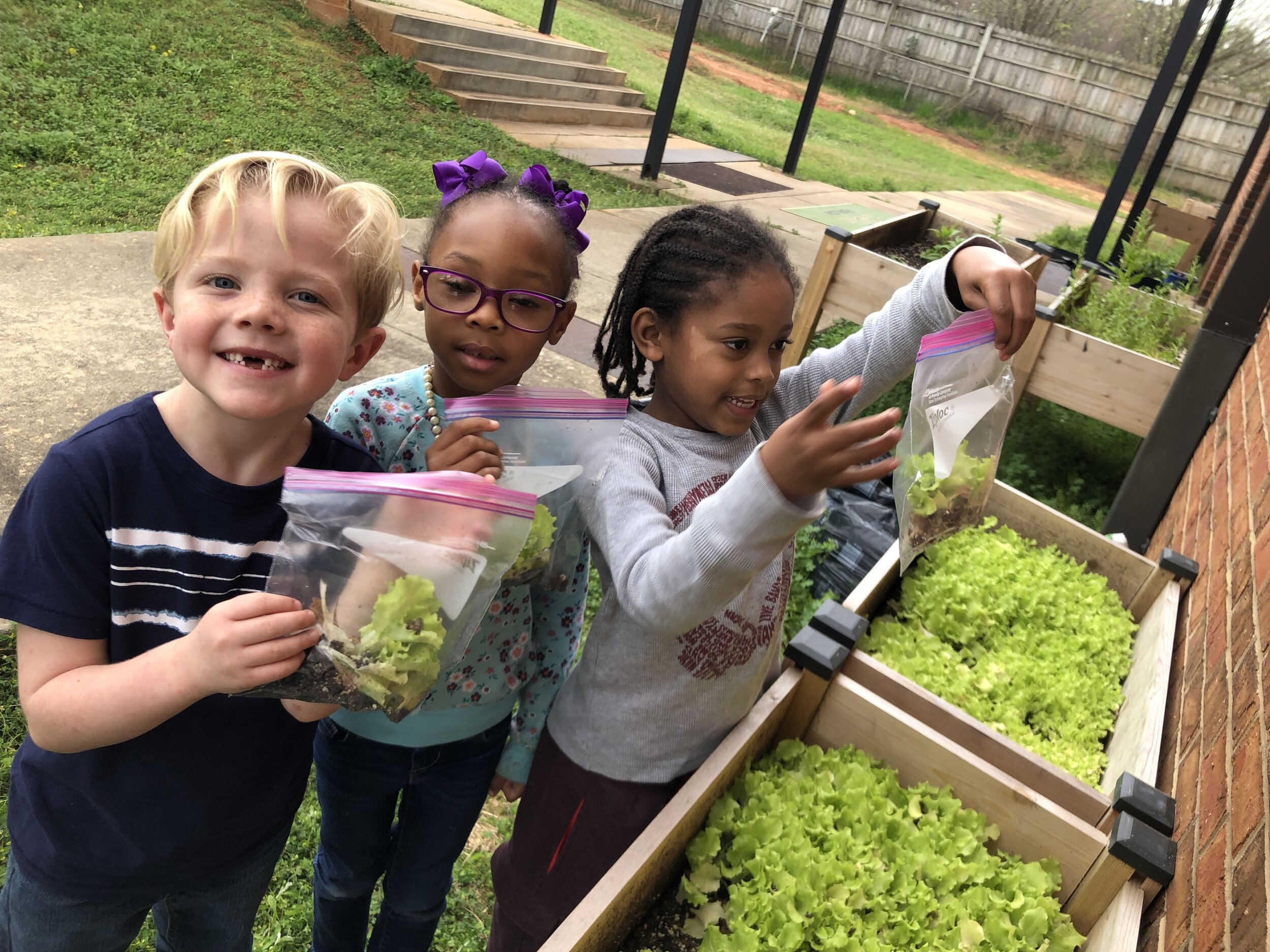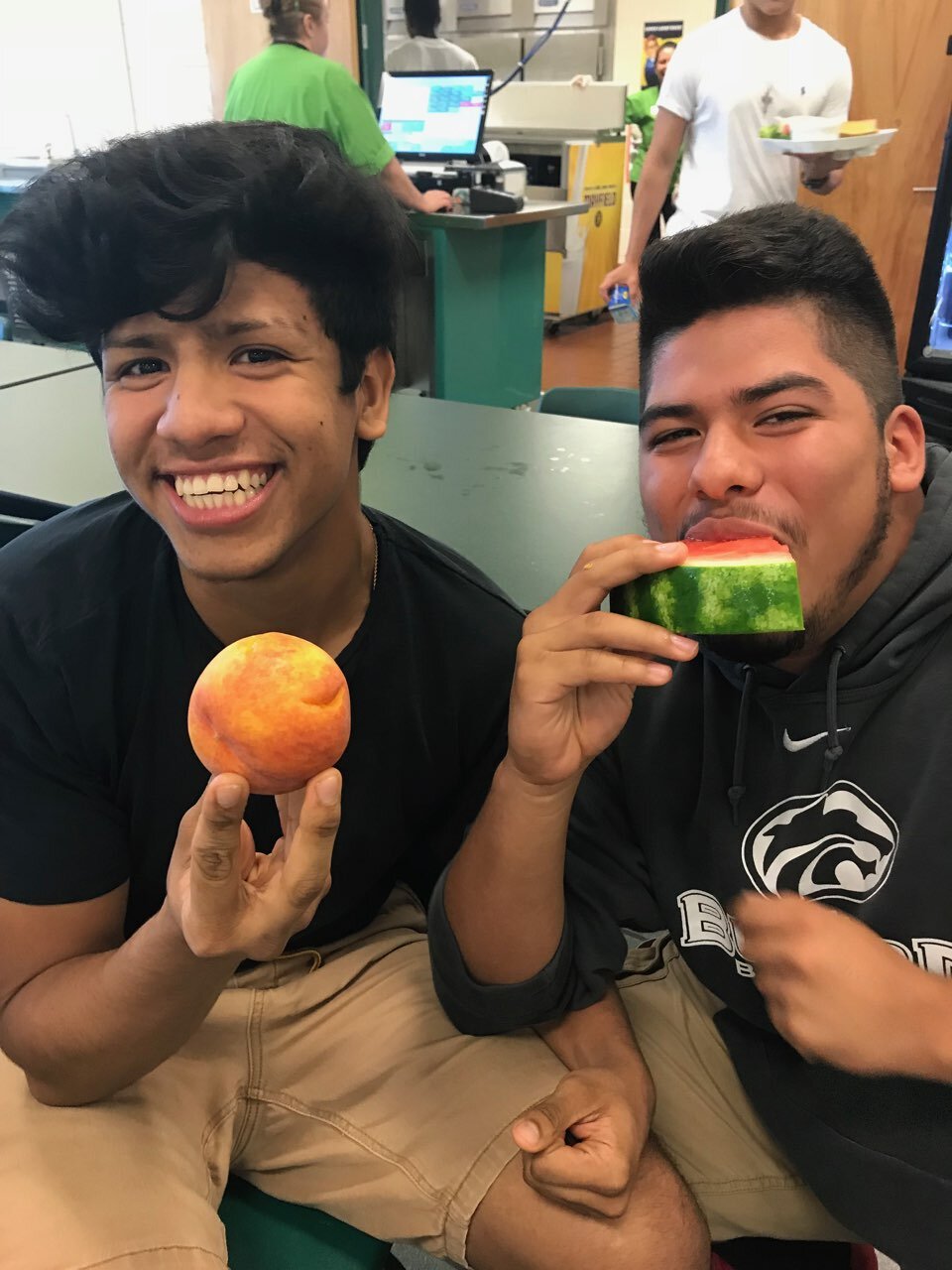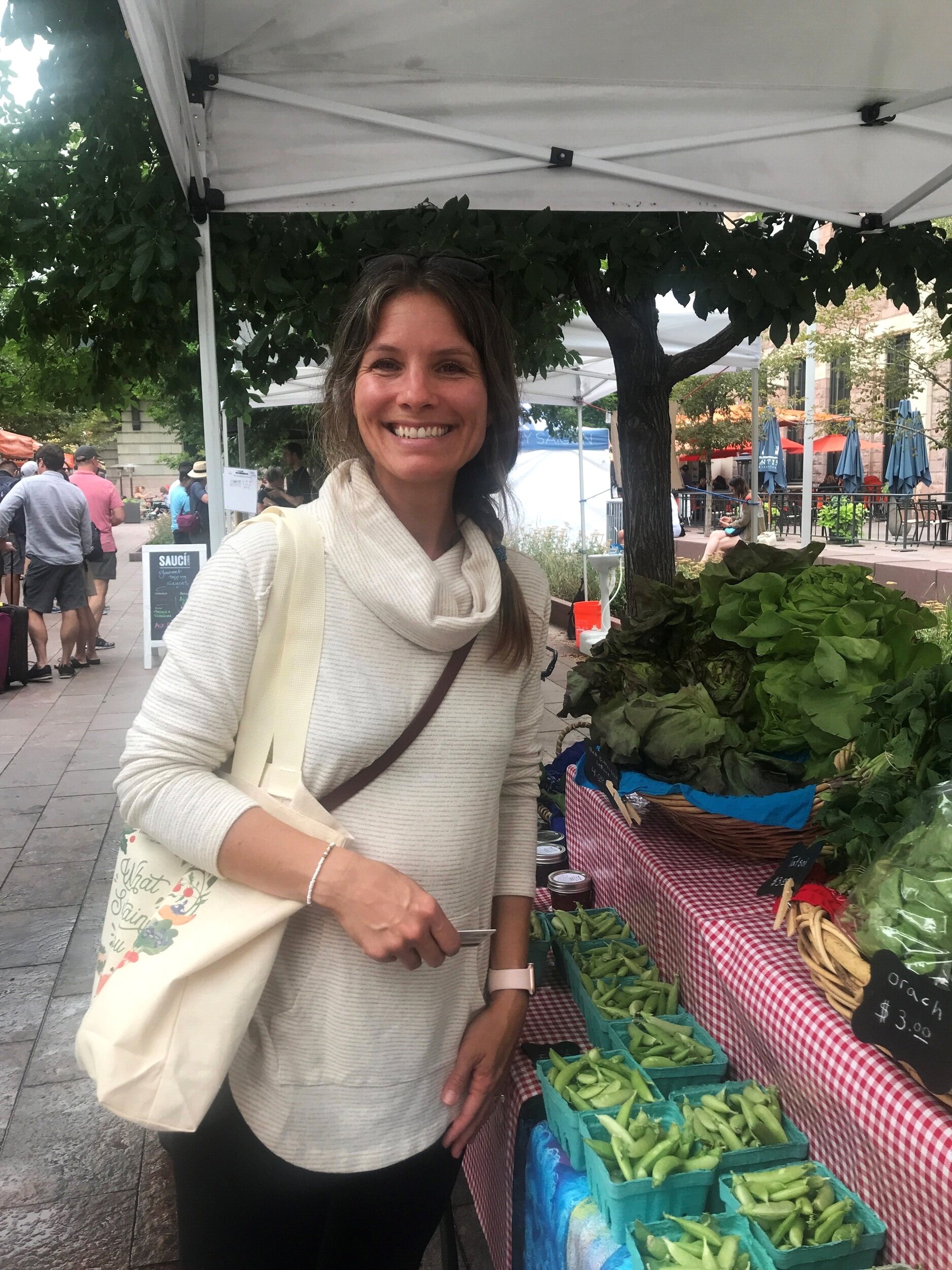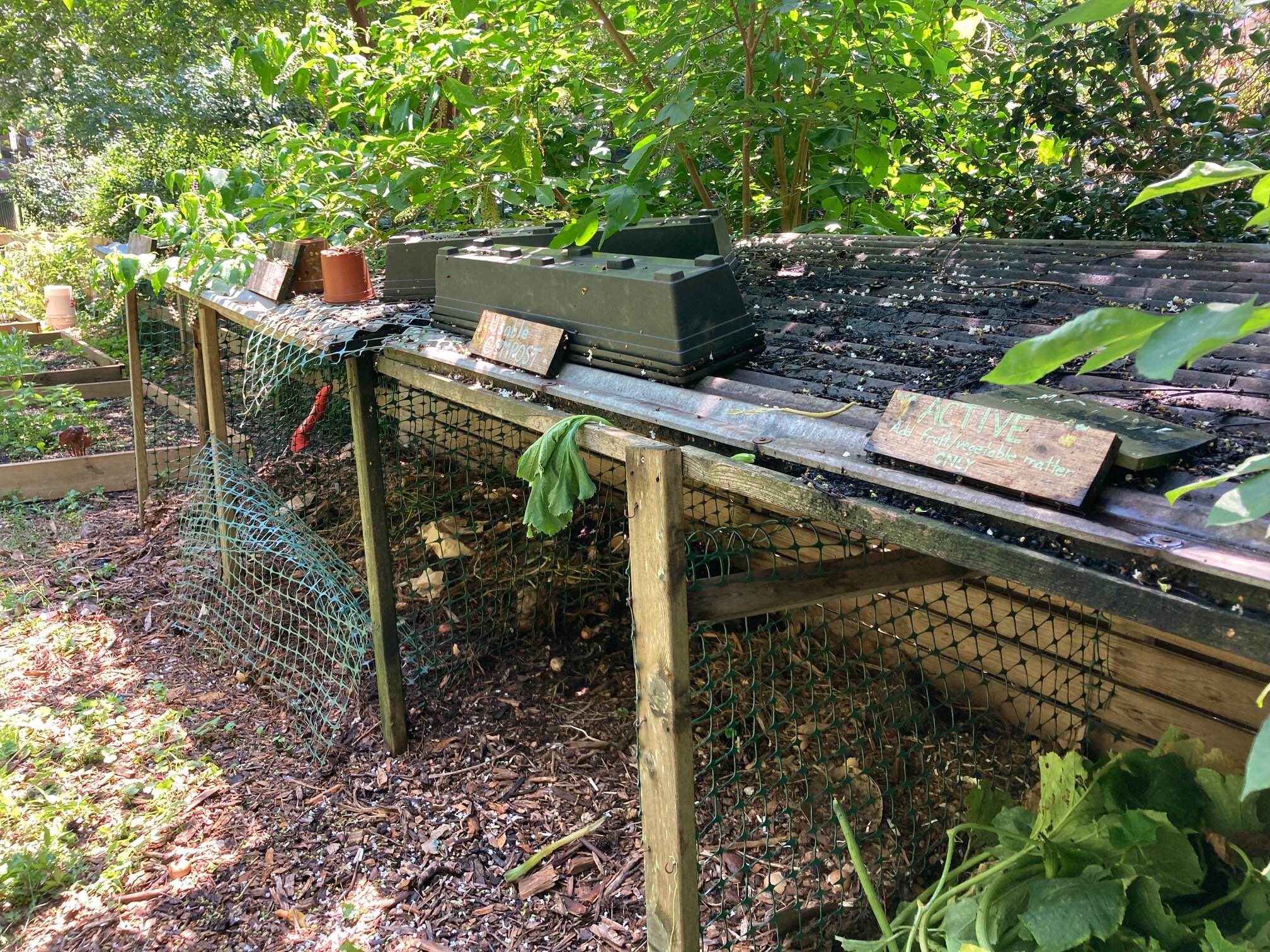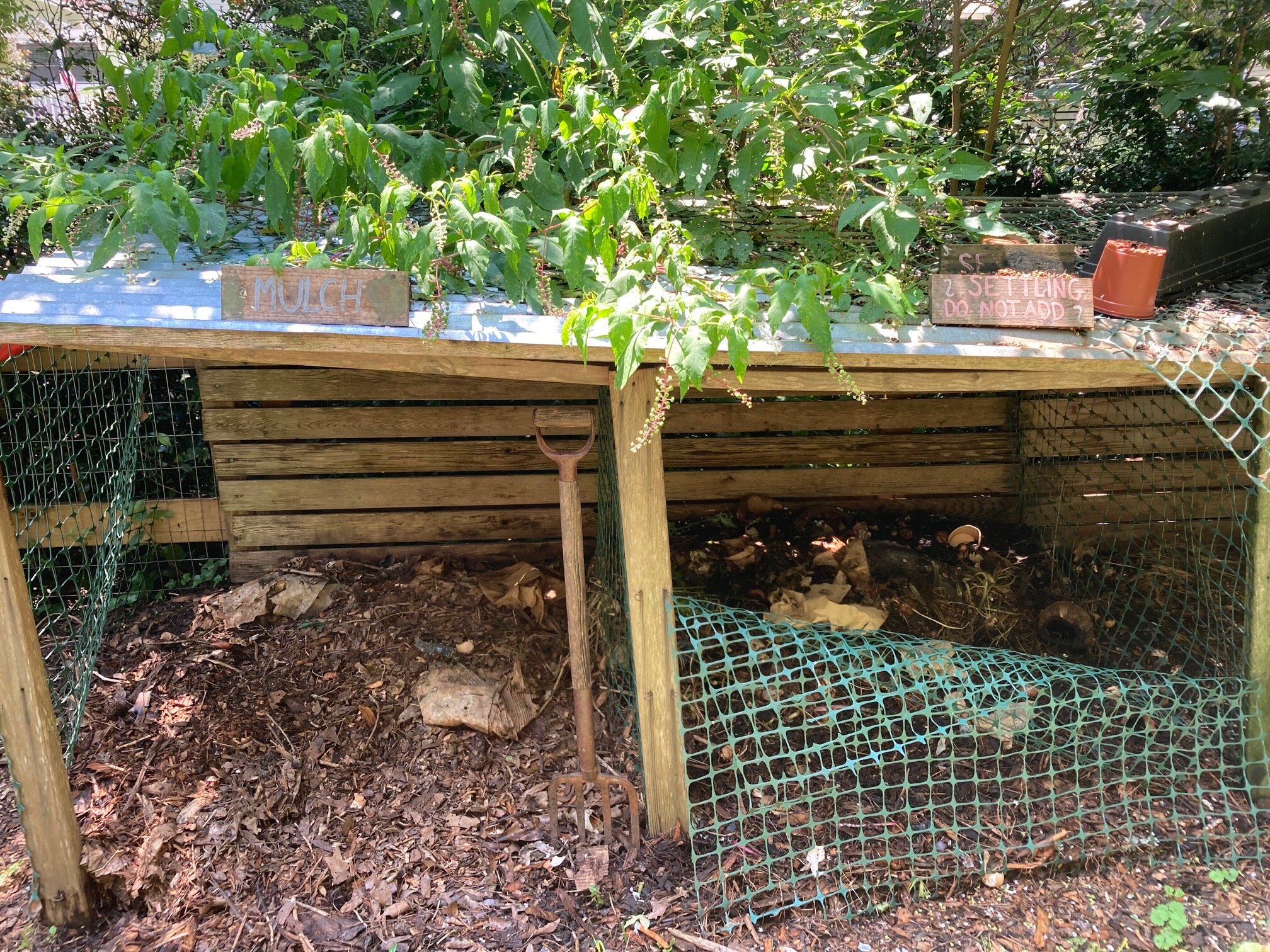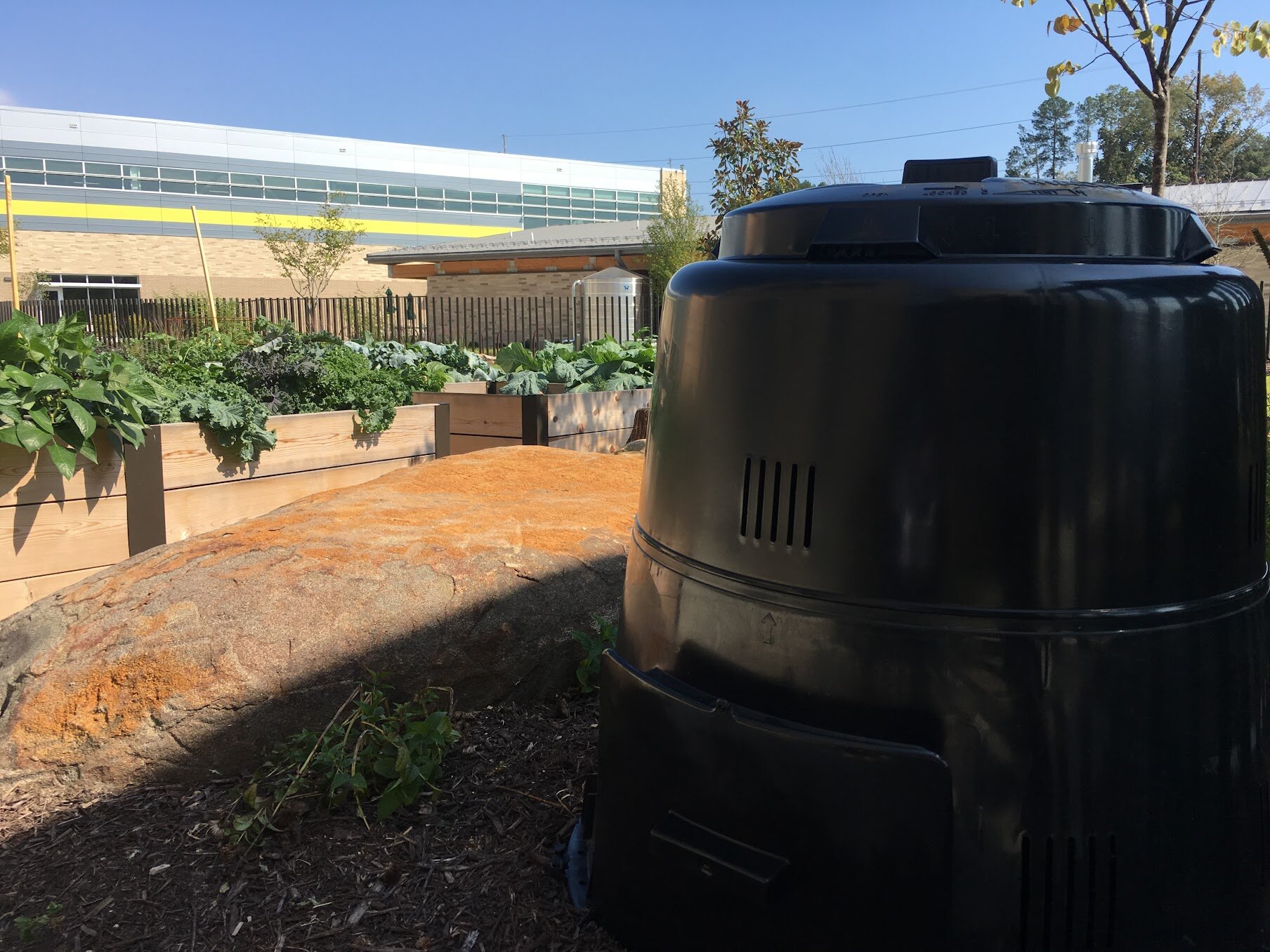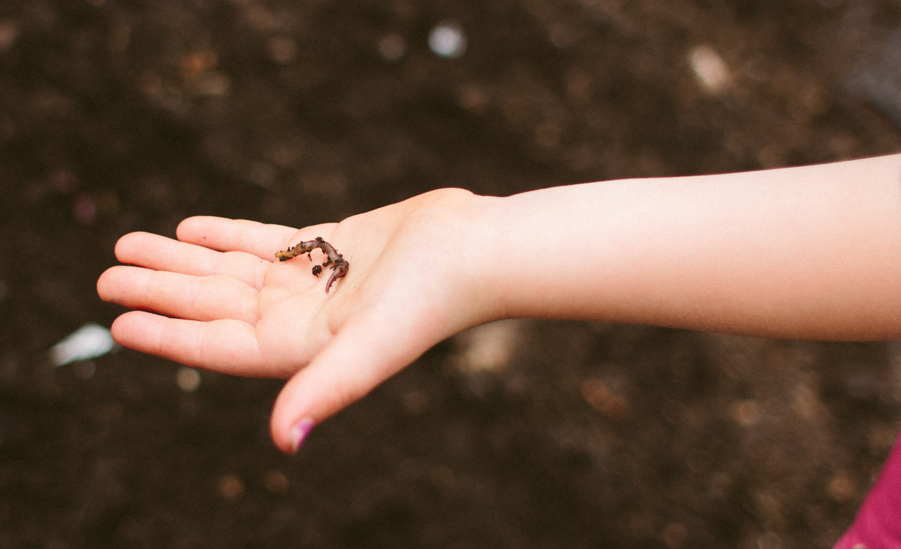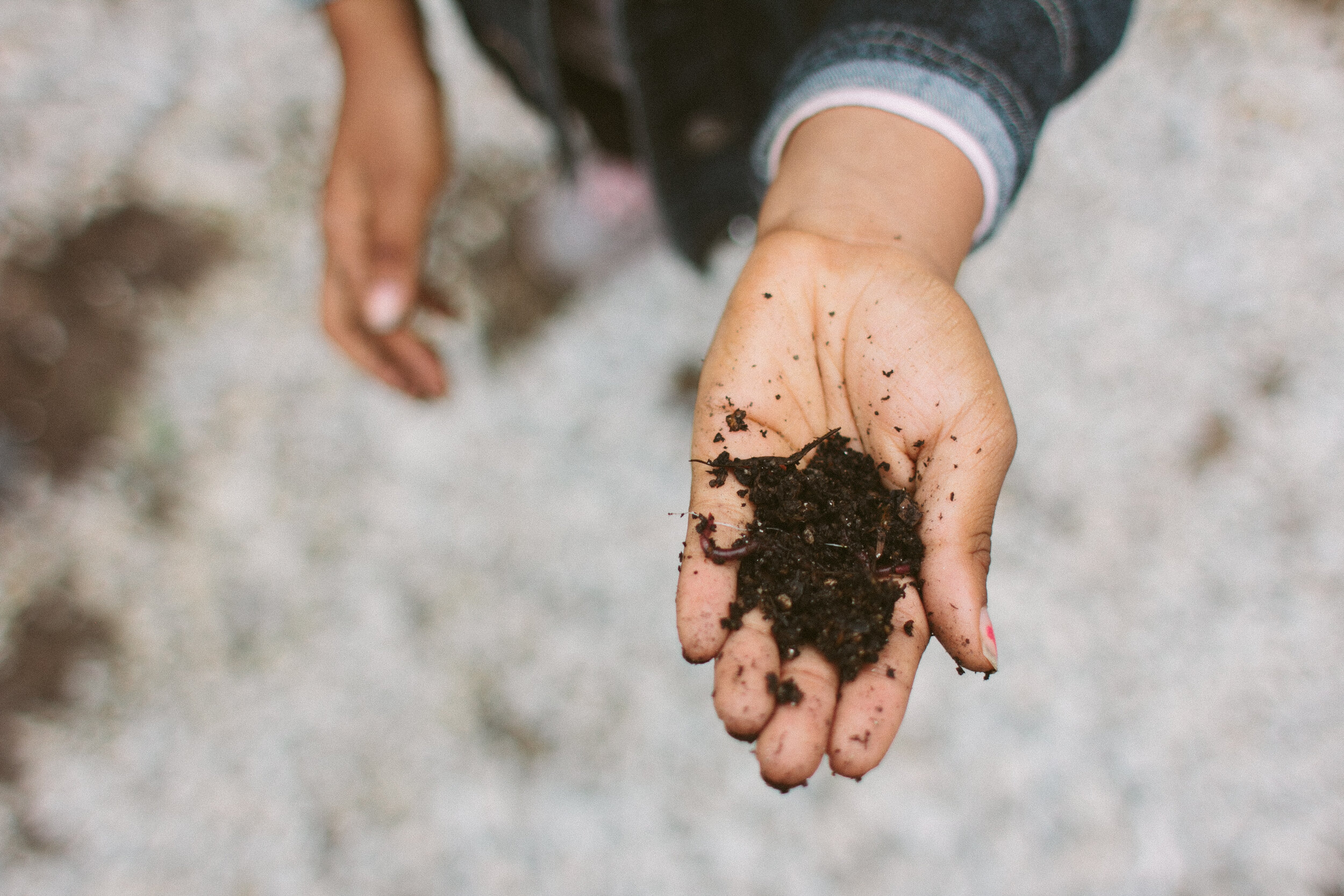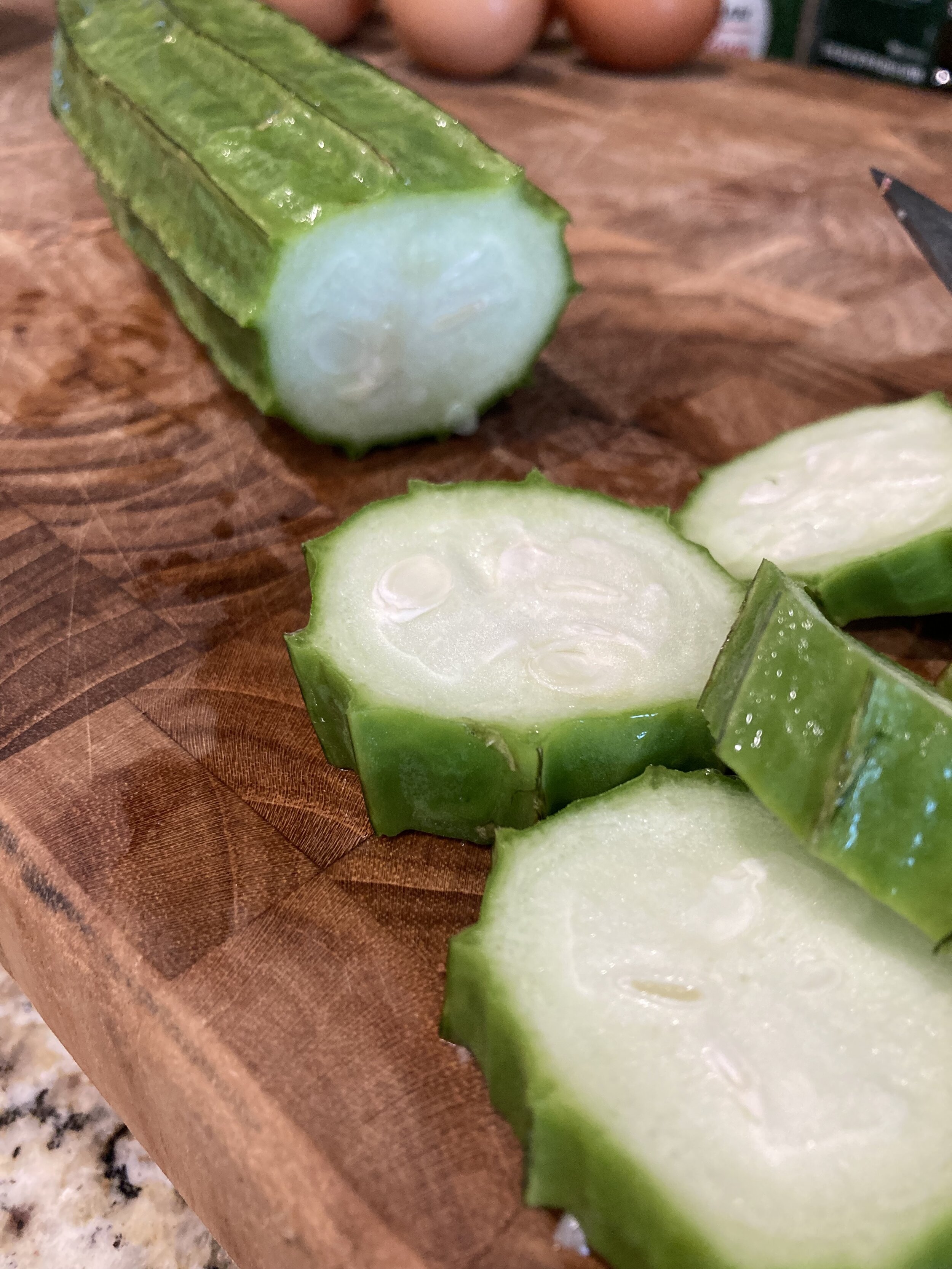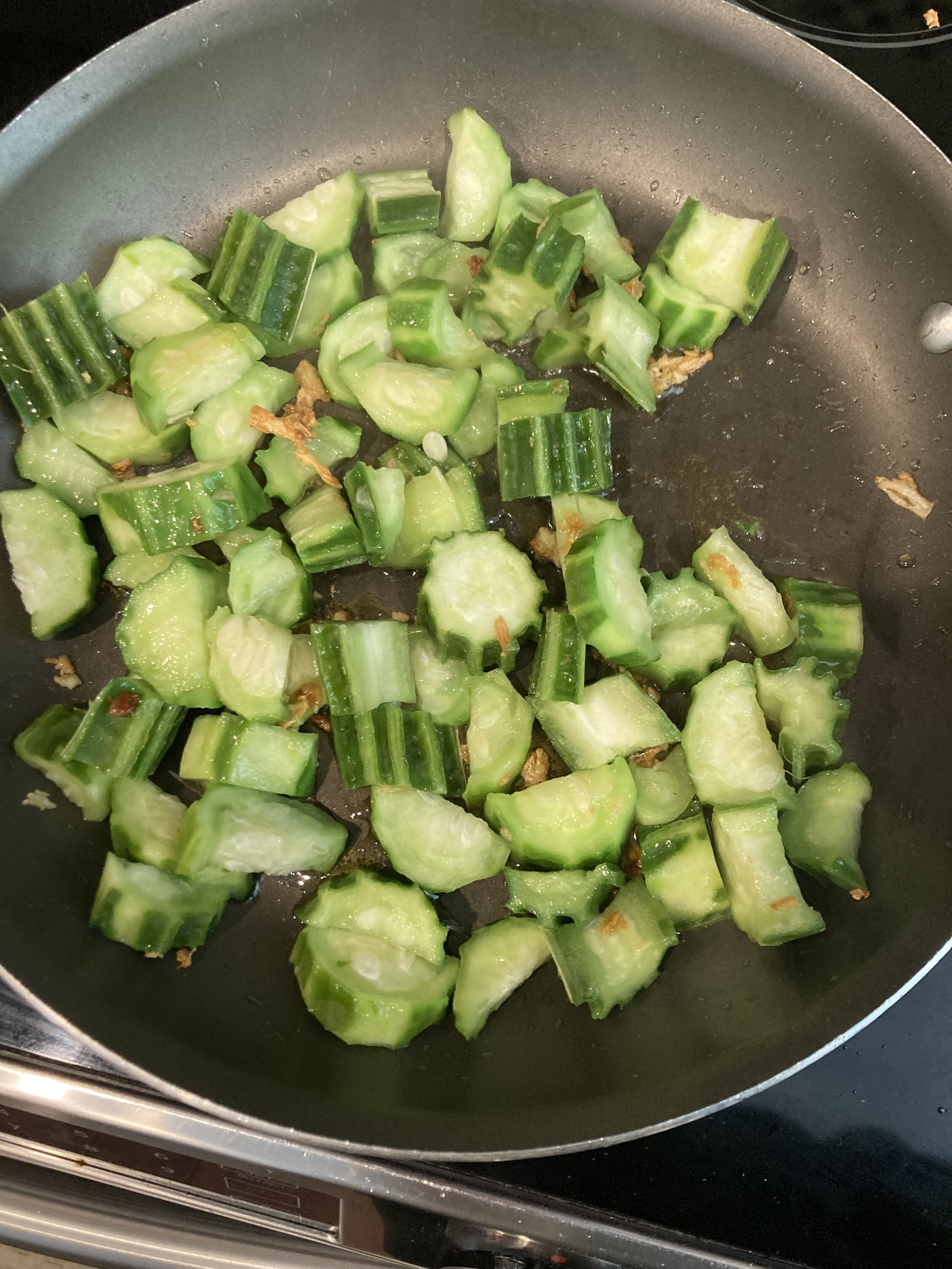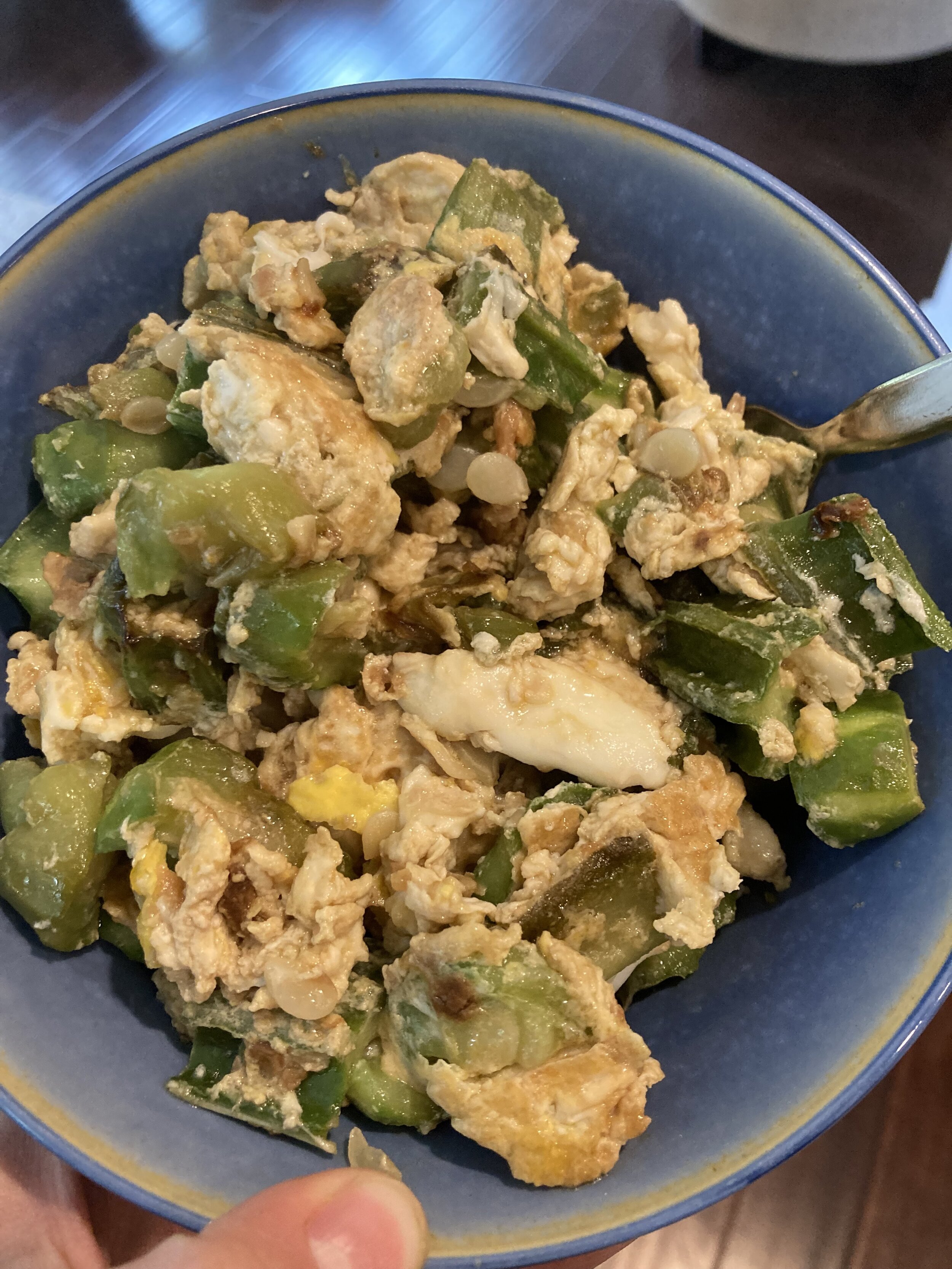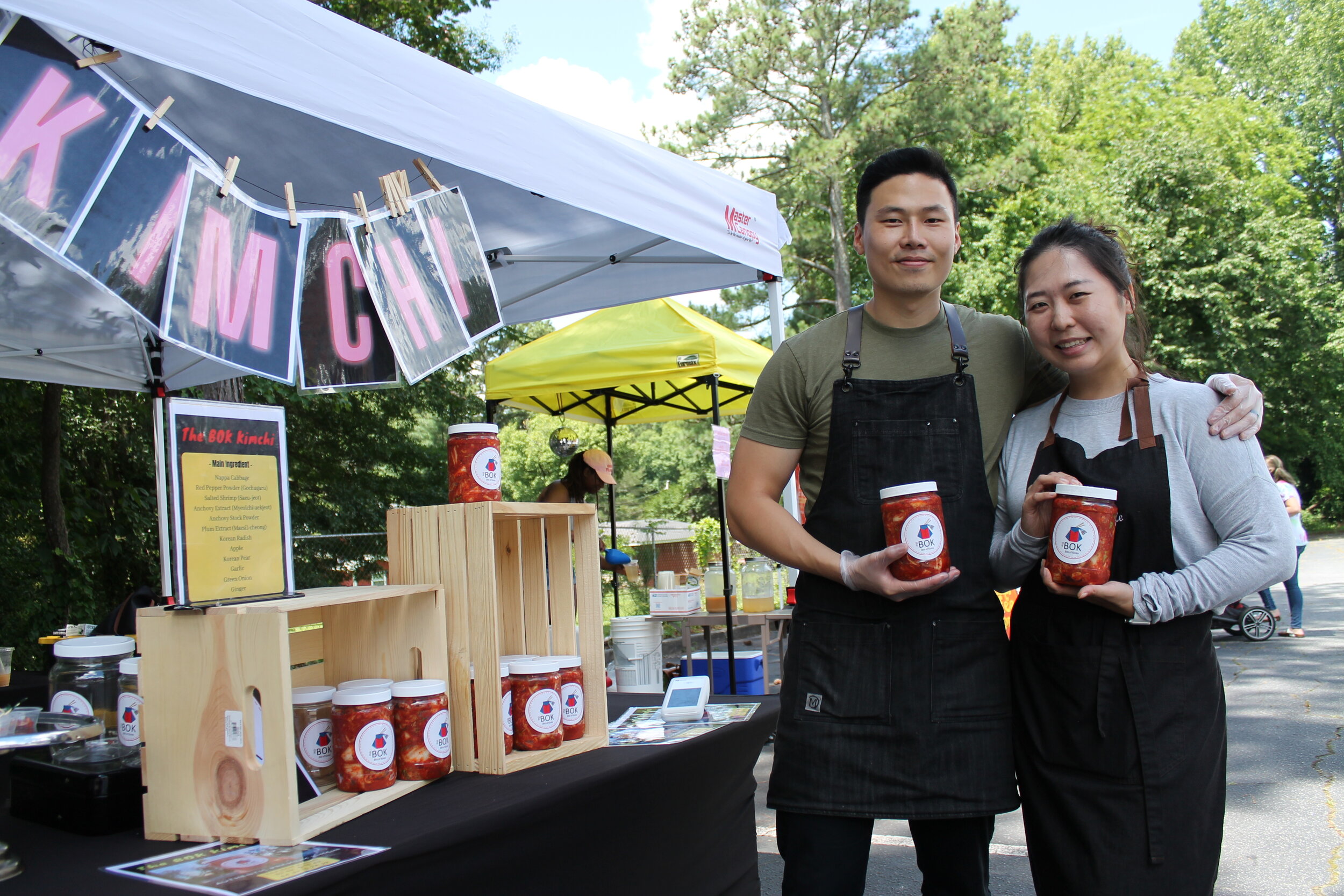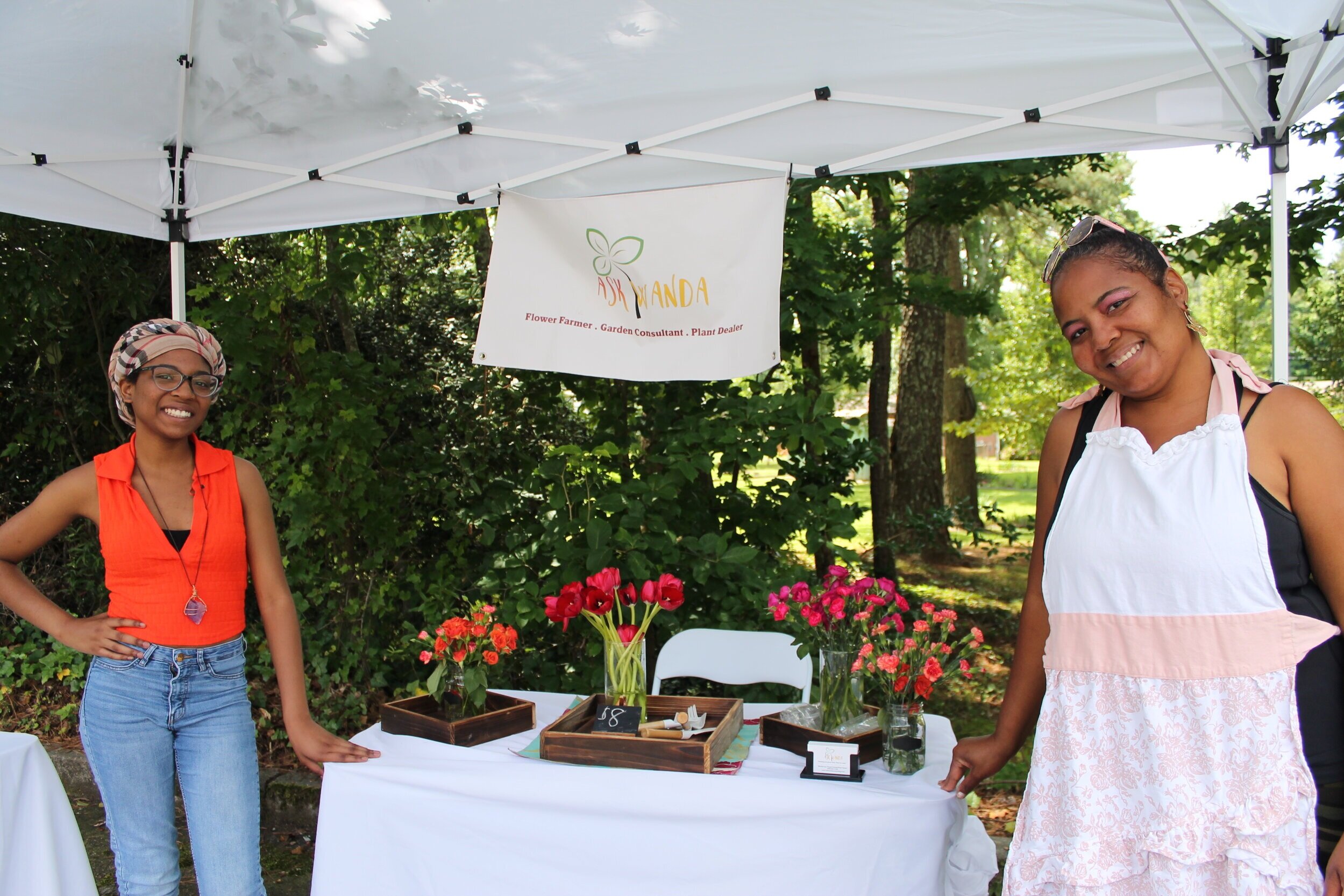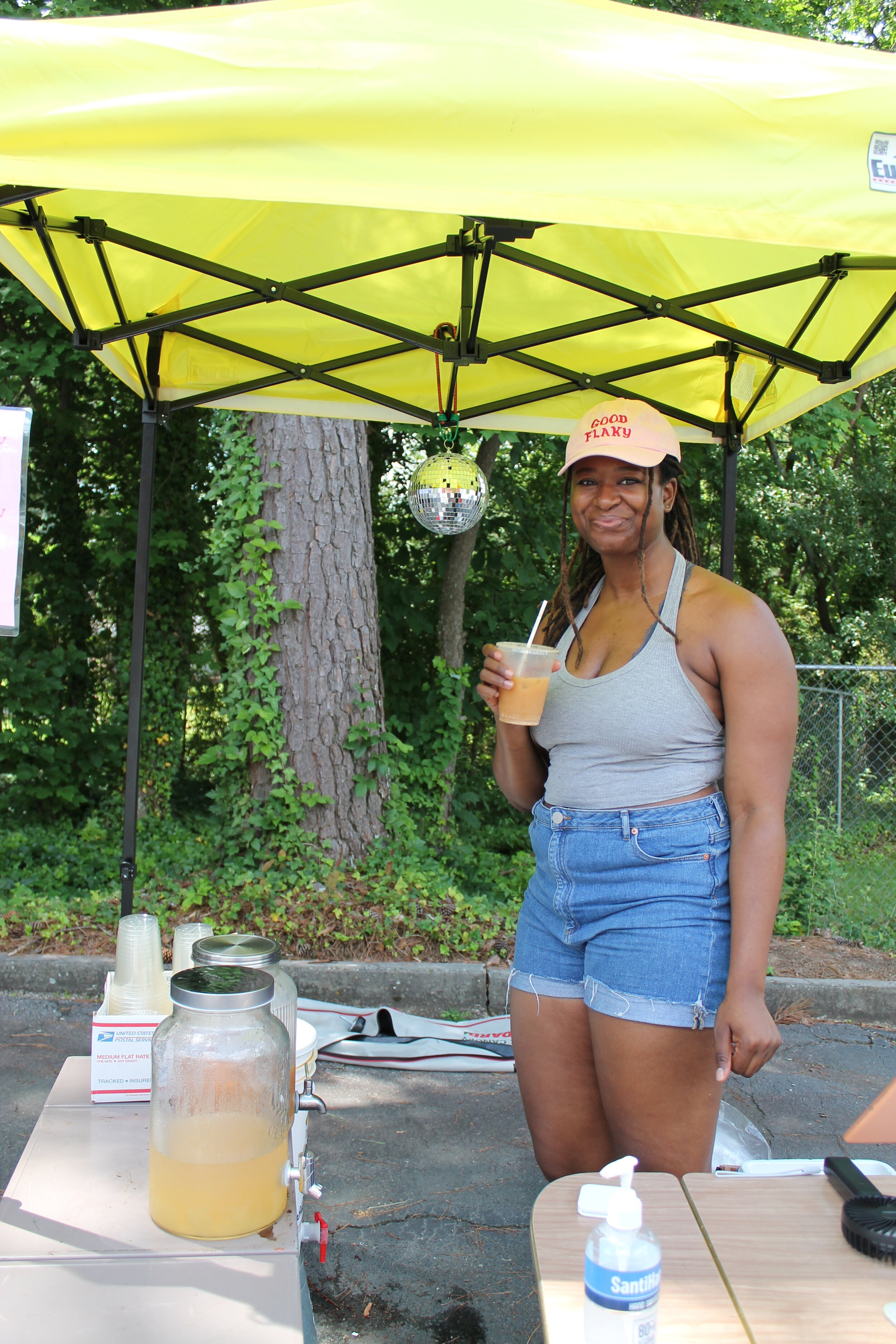To kick off our Wednesday Webinar series for October Farm to School Month last week, Brooke Lewis-Slamkova, a Family and Consumer Sciences Teacher at Barrow County Schools and a farmer at Maple Park Homestead showed us her farm and how to pickle okra using lacto-fermentation.
Good Food for Thought and Conference Announcements
By Ashley Dowling
Ashley Dowling is the former Events Manager and Conference Coordinator at Georgia Organics.
Georgia Organics has always been a convener. For more than 23 years, we have brought people together from every corner of our state and beyond for good food events and, most notably, for our annual Conference & Expo.
While nothing sounds better than coming together for a weekend at the annual Georgia Organics Conference & Expo, the pandemic has challenged us to continue to re-envision our work.
For another year, Georgia Organics has decided we will not be hosting a conference in February of 2022. While we are saddened to share this news, we are excited to continue our Good Food for Thought programming year-round.
We launched Good Food for Thought (gfft.georgiaorganics.org/) to continue our role as a convener by providing opportunities for learning and connection year-round, through panel discussions and webinars along with video resources, digital toolkits, podcast episodes, and more.
Since the program’s launch in August 2020, we have hosted over 25 virtual events engaging with nearly 800 attendees. Georgia Organics has hosted workshops for farmers, train the trainer lessons for educators and farm-to-school advocates, and brought together community leaders to gain practical experience for coalition building.
We even celebrated our 2021 Land Steward, Barbara Petit Pollinator, and Farmer Champion awardees. We could not have done this work without our partners in this movement, sponsors, and our community of engaged attendees.
While we won’t be able to gather, learn, and celebrate at the conference – we hope to see you at one of our upcoming events this fall!
UPCOMING EVENTS
OCTOBER
Join the Farm to School team every Wednesday at 3:00 p.m. for our October Farm to School Month Webinar Series! Each week, Georgia Organics and partners will be highlighting lesson plans and Livin’ La Vida Okra resources & activities for all ages and learning environments.
On October 6, take a virtual field trip to Maple Park Homestead in Winder, GA with Farmer and Family and Consumer Sciences Teacher, Brooke Lewis-Slamkova as she demonstrates how to pickle okra and other vegetables using lacto-fermentation, including how to turn this into a STEM lesson for students. Register here!
Then on October 13, Chef, Author, and Health Educator, Asata Reid, and Cobb County Extension Agent and Farmer, Terri Carter, will share the history behind the dish known as "Succotash" and demonstrate how to prepare this dish with students. Register here!
Additional webinars include a Farm to ECE demonstration in English and Spanish by Maria Claudia Ortega of My Little Geniuses Center and a session on how to use the school garden as an outdoor classroom with FoodCorps at Parkside Elementary School.
FARMER FIELD DAYS
NOVEMBER
Georgia Organics is excited to announce two upcoming Farmer Field Days! These on-farm workshops are designed to deliver continued education opportunities to current farmers, space for each on-farm workshop is limited. Registration coming soon!
Join us as we team up with farmers Lindy Kloepfer and Daniel Guzman of The Little Farm Tractor School on Sunday, November 14 for “Tractors: Soil Health and Safety with the Little Fox Tractor School” hosted at Little Fox Farm in Douglasville, GA. Attendees will spend the afternoon learning tractor safety and education, strategies for utilizing tractors to optimize soil health and gain a deeper understanding of cover cropping using a tractor.
This field day is for any beginning farmer or farmer looking to gain knowledge on tractor safety. The tractor safety lesson portion of this field day is a pre-requisite tractor safety course with Little Fox Tractor School – after completing this session attendees will be able to take more advanced tractor courses with Lindy and Daniel as they become available.
december
Then on Monday, December 13 register for Proper Planning for the New Year: Crop Rotation Workshop hosted by Daniel Parson, Farmer & Educator at the Oxford College Farm, and Lauren Cox, of Georgia Organics.
Crop planning can save you time and minimize stress when looking towards the future. At Oxford College Farm at the Emory Campus in Oxford, GA, attendees will see a field rotation in action and learn about a tried-and-true rotation model. Following the farm tour & presentation, attendees will have the option to participate in a working session where you can bring your pen, paper, or computer to tackle building out your farm’s crop rotation for 2022 with the help of Daniel Parson and the Georgia Organics Farmer Services team.
Daniel Parson, by Anthony Masterson
This field day is best for diversified fruit and vegetable farmers; farmers that want to increase production; farmers with CSAs; farmers interested in Organic certification; and farmers looking to integrate or gain a deeper understanding of cover cropping.
Stay tuned to your email and social media as we release registration for these events in the coming weeks!
To learn more about Georgia Organics, visit georgiaorganics.org, and follow them on social media @GeorgiaOrganics and at facebook.com/GeorgiaOrganics.
Farm to School Innovation Mini-Grants In Lieu of Golden Radish Awards
By Kimberly Koogler
Farm to School Coordinator at Georgia Organics
When I started working at Georgia Organics four and a half years ago, part of my job (and one of my favorite parts) was to encourage School Nutrition Directors across the state to apply for an annual Golden Radish Award, the prestigious award that recognizes GA school districts who are doing extraordinary work in farm to school.
We would then review those applications, determine award levels, and help plan a swanky, celebratory award ceremony for the much-deserving awardees.
Applications from districts all over the state would start rolling in in May, and we would spend the summer months poring over their stories, data, and photos. And the photos were SO GOOD (see below)!
As we reviewed submissions and their most adorable accompanying photos, we were able to get an idea of how farm to school programs across Georgia were starting, taking shape, growing, and impacting students.
It was joyful and inspiring to get to bear witness and participate in this process.
The pandemic has deprived us of Golden Radish for two years in a row now, and we have been hungry to know how farm to school programs have been impacted. We also just want to be in closer touch with the School Nutrition heroes and farm to school champions of our state. It is why we are so thrilled to announce our 2021 Farm to School Innovations Mini Grants Program, the next best thing we could come up with!
For four years in a row, Georgia's School Nutrition Departments told us in post-Golden Radish Award surveys that what is needed is money to support Farm to School programs.
Out of a strong desire to support the amazing work that farm to school stakeholders do on a daily basis, we decided we should just give them the funds we would have used on an awards ceremony to support innovative farm to school projects, such as school garden sustainability initiatives, school garden expansion, stipends for hosting a school-based farmers market, equipment/supplies to support menu development, and more. The funds are intended to support farm to school initiatives that:
increase access to local, fresh, organically grown food,
include culturally responsive food and education,
increase local food procurement,
and/or benefit Georgia certified organic farmers in other ways.
Through this process, we also hope to see how farm to school is looking these days, and find out how the pandemic has impacted farm to school programs.
If you work in School Nutrition, we encourage you to apply! If you don’t, we encourage you to reach out to your school system’s School Nutrition Department to encourage them to apply. APPLY HERE.
Applications are due by September 11, and we will announce the awardees on September 24.
To learn more about this mini grant program or the Golden Radish Awards, visit farmtoschool.georgiaorganics.org/golden-radish-awards, or send an email to kimberly [at] georgiaorganics.org.
Follow Georgia Organics on social media @GeorgiaOrganics and at facebook.com/GeorgiaOrganics.
The True Cost of Local Small-Scale Poultry
By Kayla Williams, Georgia Organics Farmer Services Coordinator
A craving for chicken parmesan hits you. You plan to make the sauce with the delicious tomatoes you picked up at your local farmers’ market but ponder where to get your chicken. Sure, you could grab some chicken raised in Georgia and labeled as American Humane Association Certified Humanely Raised (Certified Humane), from a nearby grocery store.
What does Certified Humane really mean though? Consumer Reports defined the label as meaning that “the animal was raised on a farm and slaughtered in a slaughterhouse that met the organization's "core criteria." These criteria include meeting basic needs, such as food and fresh water; providing care for sick and injured animals; and humane treatment on the farm, and during transport and slaughter.”
It’s a good start, but the label doesn’t require that the chicken’s natural inclinations like roaming free in a pasture is met, and the farm only needs to meet 85% of the requirements, although customers are not given the privilege of knowing which 85% of requirements are being met versus not met.
Pasture raised chicken is typically difficult to find in a typical supermarket but it’s easy to check with the poultry farmers at your local farmers’ market. Pasture raised means exactly that – the chickens are raised in a pasture, and frequently moved (sometimes daily, sometimes weekly) to another part of a field to eat bugs and fertilize the land with manure for future healthy crops to grow on (you can harvest crops 90 days after manure has been applied to the field).
Now, imagine a world in which you didn’t have to look up a label, didn’t have to guess about the kind of environment that those chickens were being raised in and knew exactly where your money was going. That world does exist, even within Georgia! The price may be higher than what you’ll find at your local supermarket and it may be a bit more labor on your end to find that local chicken, but there are some really good reasons why that price is higher.
The current Georgia Department of Agriculture’s poultry processing rules favor the large producers, stating that only farms that raise less than 1,000 birds can process on the farm. This means that if you raise more than 1,000 birds per year, you need to use an off-farm processor.
Gabriel Jimenez of Caribe United Farm
As Gabriel Jimenez of Caribe United Farm put it, “Finding a good processor is like finding a good mechanic. It requires a lot of trust, because I love and care about my animals and when I give them to the processor for them to finish, I have to trust that they are going to treat them with the same love and care.”
Melissa Nisbet of Four Bellies Farm in Bowdon, Georgia generally books with a Kentucky-based processor, a five-hour drive from the farm, one full year in advance to ensure she can get her batch processed. The Kentucky processor had a labor shortage due to COVID-19 which has been common for processors across the country which gave Melissa the impetus to find another processor as a backup plan. She has also used a processor in Sylacauga, Alabama, just an hour and a half away.
Four Bellies Farm
When I spoke to Melissa on the phone recently, her husband and business partner, Avery Nisbet, had just driven the batch to be processed in Alabama the previous evening. A few days later, he’ll go get the processed meat and trailer that he left there. That’s six hours of driving back and forth, which is notably less than the roundtrip to their former processor in Kentucky but still a significant amount of time in a farmer’s week! Gas, time, and processing fees add up. To process the approximately 580 chickens (including some getting cut up, some getting turned into sausage, as well as additional processing for feet, livers and hearts), Melissa expects they’ll spend approximately $4000 at the processor.
Until recently, there were no USDA-inspected poultry processing facilities open to small scale producers. In spring of 2021, Shaun Terry of Grateful Pastures Farm, Georgia’s only local pasture raised certified-organic chicken producer, partnered with a nearby deer processing facility in Loganville, GA to open Atlanta Poultry Processing and began filling the void for small-scale poultry producers in Georgia.
The first year Shaun started farming, he tried to process 100 birds on the farm. It took him a week to process 70 birds and after that, he decided he’d process off farm. Finding a reliable processing facility in quality, availability and convenience was always a difficulty for Shaun until he took matters into his own hands. After renting storage freezer space at one of Beth Johnson’s deer processing facilities several years prior, Shaun and Beth decided to open a poultry processing facility within the deer processing facility. He noted that having Beth’s processing wisdom, combined with the knowledge of Shaun’s former processor in Kentucky (the same that Four Bellies Farm used to use) made it possible for the Atlanta Poultry Processing facility to start up quickly.
Atlanta Poultry Processing
Folks who work with Shaun and Beth have ranged from beginning farmers coming from all over Georgia and the surrounding states with less than fifty birds up to 600 bird batches, the size of Grateful Pastures’ typical batches. When asked if creating a facility closer to home changed retail-prices, Shaun replied “No, in fact my processing costs have gone up.” The Kentucky-based processor is part of the Mennonite community so labor is cheaper, making the price per bird less than what Atlanta Poultry Processing can charge to keep themselves afloat.
Want to get in touch with Shaun and Beth? Email atlantapoultryprocessing@gmail.com.
The price of feed adds to the retail cost of local poultry as well. For a little perspective, Four Bellies needs more feed every 5-6 weeks (Freedom Ranger chickens need about 9-11 weeks to mature to full size). They buy 5 tons of non-GMO soy-free feed for their flock and most recently, it cost them $569/ton including a delivery fee. This feed goes towards both the mature chickens (who went to the processor in Alabama) and the chicks in the brooder (who will move to the tractor in a few weeks). The chicks eat a lot less than the more mature chickens so it’s hard to say exactly how much feed costs per the recently processed flock, but either way, feed is expensive. And this feed isn’t even certified organic. The prices for certified organic feed are higher–Shaun Terry pays $1100/ton.
In April 2021, a “Notice of Intent to Amend Poultry Inspection–Poultry Processing Rules” was released from the Georgia Department of Agriculture that would change Rule 40-10-2-.02. from being able to process on farm if you only raised 1,000 birds or less to 20,000 birds or less.
This rule has not yet been implemented by Commissioner Gary Black and his administration but it has been approved. If a farm has the processing equipment and labor force to process on farm, this change of rule could potentially save folks time, money, and stress. When asked if they would process on farm given the new amendment, Melissa said “At this point, probably not because we don’t have the labor or equipment, but if we were just starting out our operation with this new rule, we might.”
For Gabriel, he searched for over a year before finding anyone to help him on the farm without even considering the labor required processing on farm. Gabriel also noted that as the requirements currently stand, if you process your birds on farm, you can only sell them direct-to-consumer (like at a farmer’s market) as opposed to selling wholesale.
Shaun stated that if he hadn’t just opened the Atlanta Poultry Processing facility, he might have considered processing on farm depending on the details of the rule. If he could process whole birds as well as cuts, he might consider. If the infrastructure rules required a drainable floor, walk in cooler, and walk in freezer among all the other equipment required to process, he probably wouldn’t process on farm. Small amendments like these have the potential to open doors for small poultry farmers but unless the rules favor flexibility in cuts and accessible infrastructure, many folks will continue to outsource for processing.
Are you craving chicken parmesan still? Follow these folks to find out where you can buy some local poultry.
Four Bellies (@fourbellies on Instagram and Facebook)
Grateful Pastures (@gratefulpastures on Instagram and @gratefulpasturesfarm on Facebook)
Caribe United (@caribeunitedfarm on Instagram and Facebook)
Grassroots Farms (@grassrootsfarmsga on Instagram and Facebook)
White Oak Pastures (@whiteoakpastures on Instagram and Facebook)
Follow Georgia Organics on social media @GeorgiaOrganics and at facebook.com/GeorgiaOrganics.
Creating Rich Environments: In the Compost Bin & the Classroom!
By Kimberly Koogler
Kimberly Koogler is the Farm to School Coordinator at Georgia Organics.
Last week, in partnership with teacher and farm to school expert Jenna Mobley, our Farm to School team presented a bilingual workshop all about composting and teaching composting lessons to English Language Learners. “Creating Rich Environments: In the Classroom and the Compost Bin” (click to view) was, much like compost itself, packed with super rich content.
We covered the why, who, what, how, and where of composting—the benefits, the decomposers, the compostable ingredients, and the containers and spaces for composting—in English and Spanish. We interspersed all of that information with interactive, dynamic lessons that teach composting in a way that is accessible to English Language Learners and fun for everyone, using the ten key components of Specially Designed Academic Instruction in English (SDAIE).
Farm to school expert Jenna Mobley
If you imagine all of the info, facts, rules, tips, and tricks that were presented as brown ingredients and all of the fresh, juicy lessons as green ingredients, our workshop itself resembled a healthy compost bin.
We sang, danced, made compost cake, even used some sign language, and we learned A LOT.
You can teach a group of students how to compost, the science behind it, and why it’s important, in such a way that they are also learning English and having fun. What a productive way to teach and what a rich environment you create in doing so!
Some key takeaways in case you missed it:
Everyone can make compost! Choose from a diverse array of compost bin options for affordable, indoor and outdoor composting.
There are many “rules of three” by which you can help yourself remember the how-to's of composting and troubleshooting.
The FBI (fungus bacteria invertebrates) have a very special job—decomposition!
We can help them by giving them home, food, water, and air.
For their food, remember: if it grows, it goes.
We can put it in the pot, and let it all rot, for compost stew!
If any of the above left you wondering, you definitely need to check out the recording of this workshop, as well as our composting resources: Georgia Organics Composting Handbook in English and Spanish.
To learn more about Farm to School at Georgia Organics, visit farmtoschool.georgiaorganics.org, and follow Georgia Organics on social media @GeorgiaOrganics and at facebook.com/GeorgiaOrganics.
ECE Sourcing Solutions...sort of!
By Kimberly Della Donna
Kimberly Della Donna is the Farm to School Director at Georgia Organics. Kimberly has always been interested in local foods systems and distribution, and finds the challenges Early Care and Education (ECE) providers have finding local food supply chains especially intriguing. She thinks that seeking local sourcing solutions for early care providers seems like a good strategy for job security.
Two years ago, Georgia Organics embarked on a research project we optimistically called our “ECE Local Sourcing Solutions” project. If you’re an early care and education provider struggling to find sources of local produce, you know just how optimistic that title is!
Together with a researcher from GSU and another researcher from UGA, I set out to identify all the possible sources an early care provider in Georgia could tap for local food. We reached out to over thirty distributors and farmers that we thought definitely or possibly distributed local fresh food in Georgia. We were disappointed to only confirm and interview 15 sources, but it was exciting to create a directory of those sources specifically for ECE providers.
The Local Food Sourcing Directory listings include definitions of “local food,” as well as information on how each distributor identifies the grower of the food in their catalog. We tried to put all the information a provider needs to choose the vendor who fits with their local purchasing goals.
Our next steps were to connect at least four of those vendors to ECE providers with local food sourcing goals so we could follow their progress of the purchasing relationship and note their process. We hoped to document their challenges and successes and create models to make it easier for other ECE purchasers to set up new, local purchasing programs. We never imagined it would be so challenging! Besides the challenge of finding the right geographical matches, providers who could meet distributors minimum orders, and farmers who had the time to even talk about direct purchasing relationships, there was COVID-19- which slammed the breaks on our project for over four months while upending supply chains and ECE environments. Needless to say, we didn’t find a long list of “ECE Local Sourcing Solutions”.
Sourcing Solutions Best Practices
Sourcing Solutions Recommendations for Support Organizations
In the end, we were able to document four successful ECE local purchasing programs from different regions in Georgia. As those of us who work in early care know, there are so many different sizes, shapes, and styles of early care environments that one- size will never fit all when it comes to local purchasing. This short report shares some best practices that most providers seeking to create a local purchasing program can use as a guide, though.
There are also some common challenges (too many challenges!) to be aware of when setting your expectations.
There are even recommendations for agencies and organizations who support ECE providers.
My favorite parts are the “Success Stories”, which share the innovative and inspiring ways that four brilliant business owners have created programs that support the health and wellness of Georgia’s little eaters, those who care for them, and their communities.
Read the Farm to Early Care Sourcing Strategies infographic report here
Meet the Board: Amy McMorrow, Director, Member of Governance and FunComms Committees
By Mary Elizabeth Kidd
Mary Elizabeth is the Communications Director at Georgia Organics.
All non-profits that are strong and effective have one thing in common: a strong and effective board. Georgia Organics’ board of directors meet quarterly, serve on committees within the organization, and shape the strategic direction while helping us connect with new people, partners, and members.
In this new blog series, we’re meeting members of Georgia Organics’ Board of Directors! Stay tuned as we continue to spotlight the folks that help to guide the work of our organization.
View our full list of board members, and stay tuned via our weekly newsletter, The Dirt, for announcements on board nominations!
MEET THE BOARD
Amy McMorrow, Attorney & Community Activist. Amy serves on the Governance and FunComms (Fundraising+Communications) Committees.
Hi Amy! Give us a bit of background about yourself…
I am originally from central Illinois - the Land of Lincoln, and lots of corn and soybeans. I went to school in Milwaukee, Wisconsin, and after a couple of years in Chicago, moved to Atlanta with my husband and attended law school at Georgia State University. After graduating, I spent ten years working in environmental law at Troutman Sanders. Since leaving the practice, I have volunteered extensively with the Dunwoody Nature Center, serving in several officer positions on the Board of Directors and providing leadership in various capital expansion projects. I also spent several years managing a parent-led outdoor education program at the elementary school level, which incorporated Farm to School elements (with help from Georgia Organics!).
What brought you into the world of sustainable farming, organic food, etc.?
First and foremost, eating! But also great concern about the extensive reliance on chemical inputs in our conventional agriculture system. I believe in supporting organic farmers, research that serves to educate all eaters about the benefits of organic farming, and improving access to clean, fresh food for all who wish to stock their pantries and refrigerators with the best food available.
What’s your favorite season to shop the farmers market? Any favorite fruits/vegetables?
Summer! And nothing says summer like fresh peaches, tomatoes, and melon.
How did you first connect with Georgia Organics, what interested you the most about our work?
I first connected with Georgia Organics through the Farm to School program in its earliest stages. My friend Erin Croom introduced me to her work, and then to Alice, and opened my eyes to the good work Georgia Organics has been engaged in over the years to support our farmers, tell their stories, and advocate for organic farming across the state. This effort is so multi-faceted, and Georgia Organics is working through so many angles to connect eaters, growers, policy-makers, and so many other stakeholders. I love the concept that food is what connects us all on the most basic level.
What skills, connections, resources, expertise, etc. do you bring to the table as a board member? What appeals to you about board service with Georgia Organics?
I hope to be able to provide support to the organization in my board role in both fundraising and nonprofit corporate governance. I think it is so important for highly functioning boards to have a strong foundation in internal policy and governance. Such a foundation ensures that the substantive work of the organization proceeds smoothly and that board members and other volunteers are engaged and put to their highest and best use. We need all the great ideas and energy this staff and board bring to the table every day, and a strong organizational foundation and effective fundraising enables all that good work to flourish.
What excites you about the future of Georgia Organics?
We are nearing the conclusion of our strategic planning effort, and there's so much in store for the organization and its stakeholders. I'm excited to see us take all the lessons and opportunities presented from the last crazy year and a half, and engage with our partner organizations, farmers, eaters, and policymakers in new and creative ways that advance the mission of Georgia Organics.
Give Your Soil a ‘Rays’ with Biosolarization
By Porter Mitchell
Porter Mitchell is a Farmer Services Coordinator at Georgia Organics.
Biosolarization
Biosolarization is an organic method of weed control that uses heat from the sun to kill weeds. A farmer covers their growing area with clear plastic and keeps the soil underneath the plastic moist using drip irrigation. The sun heats the soil up to 140 degrees Fahrenheit which kills weeds and weed seeds.
Biosolarization Courtesy of Semantic Scholar
Biosolarization is also good for the soil. When the ground is thoroughly watered the water displaces the air in the soil. This creates an anaerobic (oxygen free) environment for helpful bacteria and fungi to grow and flourish. These fungi and bacteria help make nutrients more available for crops and can even kill many soil-borne diseases.
Research performed by our friends at ATTRA/NCAT shows that biosolarization is extremely effective on nutsedge, mustards, pigweed, thistle, and annual grasses. One study showed that biosolarization reduced weed coverage from 34 percent to four percent!
Tips for Using Biosolarization at Your Farm:
You must use clear plastic. Black plastic blocks the sun’s UV rays and keeps the soil from becoming hot enough to kill weeds and weed seeds. Try using old hoop house plastic to save on costs.
You must keep the soil under the plastic moist. Water thoroughly.
You must create a good seal on the plastic to keep air out and moisture in. Air coming in can cool the soil and hamper the process.
How long does biosolarization take?
It takes roughly four weeks to kill weeds and weed seeds through biosolarization but the time can vary on temperature, humidity, soil type, and weed type. It’s best practice to take notes on which area you laid the plastic, which weeds are a problem in that area, and how long it took kill the weeds. A temperature log can also be useful if you are using biosolarization during the fall, winter, and spring seasons when weather can be unpredictable.
Drawbacks of Biosolarization
Alas, there is no perfect method of weed control. Here are some drawbacks of biosolarization:
Biosolarization does not kill weeds that spread with deep rhizomes like Johnson grass.
Biosolarization is not a realistic method of weed control if you do not use drip irrigation.
Rolling out drip irrigation and plastic is time consuming, although some farmers have been successful at rolling drip irrigation lines and plastic mulch simultaneously using their plastic layers.
Keeping the edges sealed means weighing them down, and weighing them down means moving and managing heavy sandbags.
Removing the plastic, cleaning it, and storing it can be a time-consuming and messy process.
Biosolarization Courtesy of UC Davis
Biosolarization Pro-Tip
Do you know that a field or bed has the same weed pressure every year? Get a head start on weeds by using biosolarization right when weeds emerge!
Up the Ante with ASD!
ASD is short for anaerobic soil disinfestation (that’s a mouthful!). ASD causes bacteria in the soil to release compounds that act as pesticides, killing harmful soil-borne diseases and pests. ASD also accelerates breaking down organic matter.
The process for ASD is similar to biosolarization but with two important differences: the farmer spreads a thick layer of organic matter on the area before covering and the farmer uses permeable plastic mulch instead of clear plastic. Use whatever organic matter you have readily available like compost, used straw, or broken-down wood chips.
Have you tried biosolarization? Let us know your results and any helpful tips or lessons learned! Email Porter at porter [at] georgiaorganics.org
Making Soil from Scraps: The Dirt on Backyard Composting, Aug. 12 Workshop
By Melissa Needham
Melissa Needham is the summer Farm to School intern at Georgia Organics. She is a Master of Public Health student at the Rollins School of Public Health where she studies behavioral, social, and health education sciences. Melissa developed an interest in gardening and nutrition, education, and health equity while attending Appalachian State University. Interested in exploring the connection between education and health outcomes, Melissa served 2 years as a Teach for America corps member in Selma, Alabama, and 1 year as a Food Corps service member in Raleigh, North Carolina.
To learn more about composting as well as best practices for supporting and engaging English language learners in the classroom, register for the Creating Rich Environments: In the Compost Bin and the Classroom workshop on Thursday, August 12, 2021, from 4:00 - 5:30 PM. This bilingually-presented workshop hosted by Georgia Organics will lead K-12 teachers and early childcare providers through how to best to engage and support English language learners in the classroom through compost education.
Photo credit: Jenna Shea Photography
While some consider coffee grounds, fallen leaves, potato peels, and yesterday’s newspaper as just a few more items to stuff into the garbage, one man’s trash is another man’s treasure. The natural process of recycling organic matter like kitchen scraps, leaves, twigs, and yard trimmings back into a valuable and highly-treasured soil-like material is called composting. With the help of bacteria, fungi, worms, mites, and other decomposers, organic or once-living material is broken down into nutrient-rich compost.
More than Dirt
Aside from creating a rich soil amendment with loads of nutrients to add to your garden, composting diverts landfill waste, reduces greenhouse gas emissions, and revitalizes soil and water.
Composting reduces waste. Organic materials like discarded food and yard trimmings make up nearly one-third of what reaches landfills and incinerators. 1 As organic material breaks down without air in landfills, it produces methane gas—a greenhouse gas 25 times more potent than carbon dioxide. 2 Composting your food scraps, paper, yard trimmings, and more can significantly lower methane emissions.
Photos by Georgia Organics’ Farm to School Director Kimberly Della Donna
Composting improves soil. Compost breaks up heavy, compacted soils like the clay soils we have in Georgia, which allows plant roots to spread, improves soil drainage, and aerates the soil. It functions like a sponge when introduced to soil—it soaks up and holds nutrients and water where the plants need it most. Compost also contains many nutrients that boost soil health and help plants grow and function at their best.
Compost protects and revitalizes water. Because of compost’s sponge-like abilities, adding compost to the soil increases how much water can penetrate the soil which reduces runoff, prevents erosion, and replenishes springs, ponds, and lakes.
Photo by Kimberly Della Donna
The Rot Ingredients
When composting, it’s important to remember your Rule of Threes:
1. Your pile should be 3’x3’x3’
2. Add one-part green to two-parts brown.
3. Keep your pile aerated and moist.
Your pile should be large enough to maintain heat, which means that it should be a minimum of 3'x3'x3' (or one cubic yard). A smaller pile will still produce compost but will take longer to do so. Just like us, our decomposers need three basic ingredients to break down organic material: food, air, and water!
Much like us, decomposers need a balanced diet to perform optimally. We separate the two kinds of organic materials they eat into greens and browns. Green materials are high in nitrogen whereas brown materials are high in carbon. Add one-part green nitrogen-rich material, such as food waste and grass clippings, to every two parts of brown carbon-containing material like newspaper, leaves, branches, and twigs. Avoid adding bones, meat, cheese, and other dairy products or oils, dogs and cat waste, and weeds.
Aerobic organisms need oxygen, so turn your compost every week. Turning too little will result in unfinished, smelly compost. Turning too often will produce finished compost slower and may allow some harmful microbes and weed seeds to survive. Compost should be about 50% moisture, or about as moist as a wrung-out sponge. If the pile is too dry, materials will decompose very slowly and if the pile is too wet, it will produce a foul odor.
Photo credit: Jenna Shea Photography
Harvest your compost when it is a rich dark brown color, smells earthy, feels cool, and crumbles in your hand. Let your compost sit for longer if there are still recognizable pieces of food, the pile feels warm, or compost is producing an odor. With the “rot” ingredients, time, and patience, you can transform your scraps into soil from your backyard.
Creating Rich Environments
There are countless composting methods, so consider your goals, space, and waste when selecting the best method for you. Whether you choose to purchase or construct a composter, or dispose of your waste through a composting service, composting is one of the simplest ways to promote a healthy, sustainable environment.
Register for the Creating Rich Environments: In the Compost Bin and the Classroom workshop here. For additional composting resources, check out our Composting Handbook.
#LivinLaVidaOkra: Summer Adventures in Okra
By Yaza Sarieh
Yaza Sarieh is a contractor for Farm to School at Georgia Organics and a Childhood Health and Wellness intern at the Georgia Department of Public Health.
Photos courtesy of Yaza Sarieh
One recent, rainy Sunday morning, I decided to visit my local Indian grocery store. As I was walking through the door, drying my boots and shaking the water off my jacket, I saw some children run by me, playing with these gigantic, gourd-like vegetables. I had no idea what this vegetable was, and set out to find it myself. When I made my way around the produce section, I finally saw it—this three-foot-long, dark green, ridged, narrow, tough vegetable is known as Chinese okra.
Although it is botanically closer to squash and zucchini, Chinese okra is a unique variety found in many subtropical regions of the world. In terms of nutritional value, Chinese okra is an excellent source of vitamin C and a good source of dietary fiber, calcium and vitamin A. Additionally, the outside peel contains lots of iron and protein. Chinese okra is so tough and fibrous that sometimes, it is even dried out and used as a loufa!
Because I had never eaten Chinese okra before, I decided to take it home and experiment with it in new cuisines. While searching for different recipes, I found multiple dishes of Asian origin that incorporate Chinese okra.
In India and China, Chinese okra is often used in stews, stir fry, vegetable or meat dishes. I decided to try this Stir Fried Chinese Okra with Egg recipe which proved to be a pleasant surprise. The soft, spongy inside of the okra soaked up the flavor of the different sauces and spices, while the outside texture gave it a nice crunch.
What is the best way to start Livin’ la Vida Okra? Try new cuisines and learn about the importance of okra in other regions of the world!
Okra is prominent in Southern food culture, but there are so many varieties around the globe. Okra is rooted in diversity, whether it is the dynamic ways it is incorporated in different cuisines or the various types of okra plants and fruits out there, which makes Livin’ la Vida Okra a great opportunity to expand our palate and immerse ourselves in other cultures and traditions.
Sign up for Livin’ La Vida Okra activities & lessons today at bit.ly/livinlavidaokra!
Georgia Food Oasis Grantee Spotlight: Sun Market
By Suzanne Girdner
Georgia Organics’ Community Outreach Manager and lead of Georgia Food Oasis
Sun Market (eatfromthefarms.com) received a Georgia Food Oasis 2021 Planning Grant to help with launching and promoting its first market season in April 2021.
Led and managed by Gabbie Atsepoyi, a community activist living and working in Decatur, GA, Sun Market is on a mission to create affordable access to fresh local food for neighbors of communities near Columbia Drive, an area that lacks access to high quality fresh foods. Another critical start-up partner, Wholesome Wave Georgia allows Sun Market to double SNAP dollars to extend food budgets for working families.
I visited with Gabbie at Sun Market on a gloriously low-humidity morning on June 26 and met with a family of hard-working and generous vendors, who filled my arms with delicious food, and reminded me that community happens through the grace of a neighbor seeking and making space for connection with others.
1. Tell us about yourself and one of your favorite ways to celebrate with food? Or a favorite food memory?
Gabbie Atsepoyi, founder of Sun Market. Photo credit: Suzanne Girdner.
I’m Gabbie Atsepoyi (Aa-she-poo-yee), a first-generation Nigerian-American from Denver, Colorado. I moved to Atlanta in 2012 and now live in South DeKalb with my partner, Brent and 2-year old child. I graduated from Spelman College where I studied the environment, specifically policy, soil science and carbon cycling, so I love the earth and I’m committed to sharing with others the impacts of climate change on our world.
I also really love food and believe access to fresh produce is a basic human right. Food sovereignty within our communities deserves a special spotlight in conversations relating to equity, health and environmentalism. So I’m happy to share Sun Market’s purpose to our neighbors to jump start important conversations.
As a Nigerian-American, when in Nigeria, I grew up eating most meals served family-style. I have strong memories of the aromas and the associated story of each produce purchased from the market. Because my parents are immigrants so were many of their friends, and as a child each new family friend I met exposed me to new flavors, aromas and traditions. In this way I grew up eating to experience culture.
2. Why do foodways and fresh food access matter so much to you?
My great-grandfather in Nigeria gifted all of his sons, including my grandfather, land to care for and steward. My grandfather managed the land, and my grandmother sold their produce at the market. They were able to provide for their large family through farming for themselves and others. So this idea of caring for the land and feeding the next generation was very normal to me, and part of my family’s tradition. Later in college, I went to a seminar and the conversation focused on the soils of Africa--such a vague word for a vast continent with many countries!--and the presenting researcher went on to suggest corn species that would “help” people eat more nutritious foods. It was a complete shock to me — the Nigeria I knew was lush with fertile soil and had diverse and abundant crops that are more nutritionally dense and better for the environment than any species of corn could be (no shade to corn, and its complex food history).
3. Tell us about Sun Market?
Sun Market is a local farmers’ market that exist only because of the sun. Thanks to the sun and soil we are able to utilize produce for energy and nutrients. Our main objective is to share locally grown produce to our neighborhood. When I first moved to Atlanta, I was amazed by the offerings at the farmers markets. So much grows in Georgia! As I was starting to plan Sun Market initially, I was hoping to invite farmers out to vend, but as a new market that was harder than I anticipated--it’s really hard to be a new and unknown market and attract farm vendors! So I responded to this detour in my plan by buying produce wholesale from farmers, and then selling pre-packed produce bags filled with seasonal greens, herbs, root vegetables, and fruits — all sourced exclusively from nearby Black farmers. Luckily, the produce bags have proven beneficial at establishing a steady supply of produce, and helped us in setting a weekly budget and price point for shoppers. Our bags are filled with a week’s worth of produce, and separately shoppers can purchase mushrooms, eggs, and honey. Our produce bags cost between $35 or $40 per bag. We accept and double SNAP/EBT which means we can offer these bags to SNAP households between $17 or $20. So far the farmers have been open to the arrangement because they save time and are able to avoid traveling to another market, and we pay them on time. It’s a mutually beneficial relationship that I hope will grow. We want to pay Black farmers and share produce grown by them to our historically Black community while also addressing food insecurity and fresh food access.
4. It feels like there’s a real sense of intention at Sun Market, from the produce sourcing to the rotation of market vendors each week, so there’s always something different but a real sense of global community. Tell us about the experience(s) you’re facilitating between vendors and community in this way?
We are intentional about our mission - the rest has been divine alignment. Columbia Drive United Methodist Church was one of our first supporters and every week they allow us to show up, use the refrigerators, store our equipment and occupy their parking lot. They also provide a warm welcome to the Sun Market community. Each week, a new vendor or reoccurring vendor shows up to share a product they grew, a food they specialize in, or a group of foods unique to their culture and life experiences. We like to say that “Our vendors reflect the diversity of this country” because it’s true! We are so grateful for the pop-up food scene of chefs that support our mission each market. In the rain or on a hot Georgia day we fall in love each week with our neighbors (near and far) who come to our market for food and produce. After 2020 this type of gathering feels so fulfilling - here we all are - gathering together (outside), eating food from around the world, surrounded by fresh local produce and we are laughing and enjoying flavors — together. Sun Market cultivates diversity in age, ethnicity, culture, economic background and in experiences and we’ve been able to do this by aligning on a mission that uplifts and supports the community we serve and live in.
5. What are the biggest challenges you’re facing right now in your first season as a market?
Whew. Time. I work in paid media and I have a toddler and a family. But thanks to the help of my partner and our friends and family we get things done.
Our second biggest challenge is locating new Black farmers that are ready to sell through our market. In my “Request for Support” letter than I share with farmers, I suggest partnering with Sun Market and the Candler Black Market, led by Neelah Hinds. I hope by offering two back-to-back markets to vend at, we can create an opportunity for our community to purchase fresh produce during the weekends.
Because I’ve had conversations with farmers and I’m aware of the lack of monetary and foundational support Black farmers receive in Georgia and nationally. I approach every new conversation to vend with grace and understanding. I’m new to the Atlanta agriculture space and there’s a lot for me to learn. I’m hopeful that in each year we will grow our partnerships with Black farmers, supporting organizations and community members who support our mission.
6. What are some positive lessons you’ve learned 3 months into managing a market?
1. Word of mouth is everything!
2. People are happy to support and show-up.
3. Food is really the meeting point for community.
4. Leafy greens are so sensitive!
7. What’s your hope for Sun Market over the next 1-2 years?
In two years, I hope to be working towards a brick and mortar location for Sun Market with standard hours. That operates as a farmers led co-op with sliding membership fees that’s located in a food desert like the one we are currently located in South DeKalb County.
8. What are the best ways for folks to get engaged as shoppers, potential vendors, or sponsors?
· Every Saturday (April-Sept): 11am-2pm at 2067 Columbia Drive, Decatur 30032
· Website: eatfromthefarms.com/
· Instagram: nstagram.com/eatfromthefarms/
· Accepts & Doubles: SNAP/EBT
Good Food for Thought: Ready? Set? Plant! Livin’ la Vida Okra!
By Kimberly Koogler
Kimberly Koogler is the Farm to School Coordinator at Georgia Organics and a former farmer at Cosmos Farm, where this event took place.
Last week the Farm to School team gathered on a hot, sunny day at Cosmos Farm in Carrollton, GA to start livin’ la vida okra.
We began by reviewing how you can participate in Livin’ la Vida Okra and what you get out of it. Then we covered the basics of planting okra on a small scale, and Little Ones Learning Center’s garden educator Farmer Trin and their PreK class showed us how to plant okra in one of their raised bed gardens.
As it turns out, preK students are really good at instructing how to plant okra seeds, and they look very cute while doing so!
Farmer Trin and Georgia PreK planting okra seeds at Little Ones Learning Center in Forest Park, GA
Finally, Farmer John Davis professed his undying love for okra, showed us how they plant okra at Cosmos Farm, using his old, faithful tool, the Earthway seeder. He also shared with us a couple of funny okra harvesting stories, involving a snake and the notorious “okra itch.”
Farmer John demonstrated how they plant okra seeds at Cosmos Farm using a nifty tool, the Earthway seeder.
It was a fun way to kick the summer off and to get some okra seeds planted in anticipation of October Farm to School Month! In case you missed it, here are some key takeaways:
· Okra is easy to grow, low maintenance, highly productive, resilient, and beautiful!
· The sooner you plant it, the more okra you’ll be able to harvest, up until the first frost.
· There are so many ways to enjoy okra, pickled being one of the favorites at Cosmos.
When you sign up to participate in Livin’ la Vida Okra you’ll get access to our robust online resource toolkit, which includes Georgia standards-based lessons for early care through 12th grade, fun, educational activities, fact sheets and growing guidance, and a delicious and diverse array of okra recipes shared by fellow Georgia farm to school stakeholders!
Watch the recording on our YouTube channel here, and sign up to join in on all the Livin’ la Vida Okra fun here!








